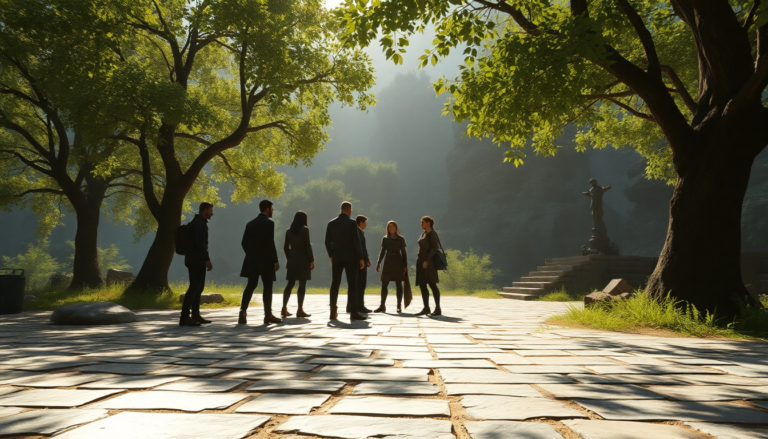Argomenti trattati
Artificial Intelligence (AI) is revolutionizing the gaming industry like never before, sparking remarkable advancements in game design, player engagement, and the overall experience. As AI technologies evolve, they’re being woven into various elements of gaming, enhancing everything from character behavior to environmental dynamics. So, how is AI transforming the gaming landscape and making it smarter and more immersive for players worldwide? Let’s dive in.
The Evolution of NPCs through AI
AI-driven non-playable characters (NPCs) are truly a game-changer. Gone are the days of rigid NPCs that simply follow scripts. Today’s AI-powered characters adapt dynamically to player actions, creating a more engaging and lifelike experience. Take “The Last of Us Part II,” for example. Here, NPCs not only display emotional depth but also tactical intelligence, enriching the storytelling and gameplay. According to research from Newzoo, around 70% of game developers are investing in AI to boost character realism—a significant shift in how stories are told and experienced in games.
This evolution in NPC behavior elevates the narrative while enhancing gameplay, making interactions feel more authentic and engaging. Players are no longer just battling static opponents; they’re engaging with characters that learn and react, presenting a unique challenge every time they play. Isn’t that a compelling reason to dive back into your favorite games?
Procedural Content Generation: Expanding Game Worlds
AI is also transforming how game environments are crafted through procedural content generation (PCG). This technology automates the creation of expansive game worlds, minimizing the need for exhaustive manual design. Games like “No Man’s Sky” and “Minecraft” harness AI to generate endless landscapes, ensuring players have fresh experiences each time they dive in. Statista reports that 65% of developers believe PCG significantly boosts player retention by continually offering new content. How cool is that?
Beyond enhancing player retention, AI-driven PCG cuts development costs and opens vast exploration possibilities for players. This innovative approach is a boon for indie developers, allowing them to craft complex and engaging worlds without the need for extensive resources. Imagine the creative potential this unlocks!
Personalization and Player Engagement
Another critical aspect of AI in gaming is its ability to personalize player experiences. By analyzing behavior and preferences, AI can adjust difficulty levels, suggest missions, and tailor in-game events, keeping players engaged. For instance, “Red Dead Redemption 2” modifies interactions based on player choices, significantly enhancing immersion. A study by Accenture found that personalized gaming experiences can boost player retention rates by up to 30%. Isn’t it fascinating how tailored gameplay can lead to deeper connections with games?
AI’s capacity to adapt gameplay to individual styles means that every gaming session feels unique, fostering long-term loyalty among players. As the gaming landscape evolves, the significance of personalized experiences powered by AI will only grow, offering players adventures that resonate with their preferences.
AI’s Role in Game Testing and Quality Assurance
AI is also making waves in the realm of game testing and quality assurance. Traditional manual testing can be labor-intensive and time-consuming. In contrast, AI-powered bots can simulate thousands of gameplay scenarios, identifying bugs and performance issues efficiently. Companies like Ubisoft are leveraging AI to streamline their quality assurance processes, potentially reducing debugging time by 40%. Isn’t that an impressive leap forward?
With AI-driven testing, developers can ensure their games are polished and ready for release, enhancing player satisfaction and minimizing the need for post-release patches. As the gaming industry continues to grow, incorporating AI in testing will be critical for maintaining high-quality standards.
AI in Competitive Gaming and Esports
The rise of esports has also seen AI playing a pivotal role in enhancing player performance and strategy optimization. AI-driven analytics tools analyze gameplay patterns, offering real-time feedback that helps players refine their skills. Notably, OpenAI’s “Five” made headlines by defeating professional players in “Dota 2,” demonstrating AI’s potential in competitive gaming. Can you imagine the impact this has on training methods?
As the esports market is projected to generate $1.8 billion in revenue by 2025, AI’s contributions to player training and strategy analysis will be essential in making esports increasingly competitive. By helping both casual and professional players optimize their gameplay, AI is set to redefine the competitive gaming landscape.
Looking Ahead: The Future of AI in Gaming
As we gaze into the future, it’s clear that AI will play an increasingly vital role in shaping the gaming industry. From crafting more lifelike NPCs to automating content generation and enhancing player interactions, the possibilities are expansive. With advancements in machine learning and natural language processing, NPCs are expected to become even more responsive, capable of holding realistic conversations with players. How exciting is that?
Furthermore, as AI technologies continue to progress, we can anticipate even more immersive experiences, allowing players to engage with games in ways that were previously unimaginable. The gaming industry is on the brink of a transformation, and the integration of AI promises to elevate player experiences to new heights, making the future of gaming more dynamic and interactive than ever before. Are you ready for what’s next?

